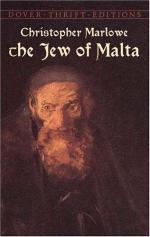|
This section contains 307 words (approx. 1 page at 400 words per page) |

|
The Jew of Malta Summary & Study Guide Description
The Jew of Malta Summary & Study Guide includes comprehensive information and analysis to help you understand the book. This study guide contains the following sections:
This detailed literature summary also contains Bibliography and a Free Quiz on The Jew of Malta by Christopher Marlowe.
Christopher Marlowe's fourth play, The Jew of Malta, is thought to have been performed as early as 1590, although the first recorded performance was in February of 1592. This play was probably written In 1589; however, it was not actually published until 1633, long after Marlowe's death. The title page describes the playas the "Famous Tragedy of the Rich Jew of Malta," but it is also often described as black or satiric comedy, and so, any indication of tragedy is eclipsed. And indeed, Barabas does not elicit the audience's sympathy as a tragic hero, as might be expected. However, in spite of this lack of a tragic hero, the play was very popular in Renaissance England, encompassing as it did attacks on both Roman Catholics and Jews, two favorite objects of distrust. The Jew of Malta was performed many times, both at court and in the theatres of London, prior to the theatres' closing in 1642. The play is filled with blood and murder, also favorite topics of the Elizabethan audience, who embraced the bloody revenge tragedies of the period. Marlowe's own reputation for violence and an unconventional lifestyle probably added to the play's attraction. Three years later, Marlowe's own bloody death would make the violence of the play even more attractive. There is no known source for Marlowe's play, although the image of the Jew as a greedy usurer was a common image in the English theatre. Marlowe was interested in depicting the differences between what men professed and what their actions revealed. Thus the dangers of Catholi cism, the corrupting force of the Jews, and the characters' own greed proved to be important themes when the play was first produced. For a modern audience, however, the visible stereotyping of Jews, with its accompanying images of the destructive Force of anti-Semitism, often offends the audience, thereby limiting its production.
Read more from the Study Guide
|
This section contains 307 words (approx. 1 page at 400 words per page) |

|



